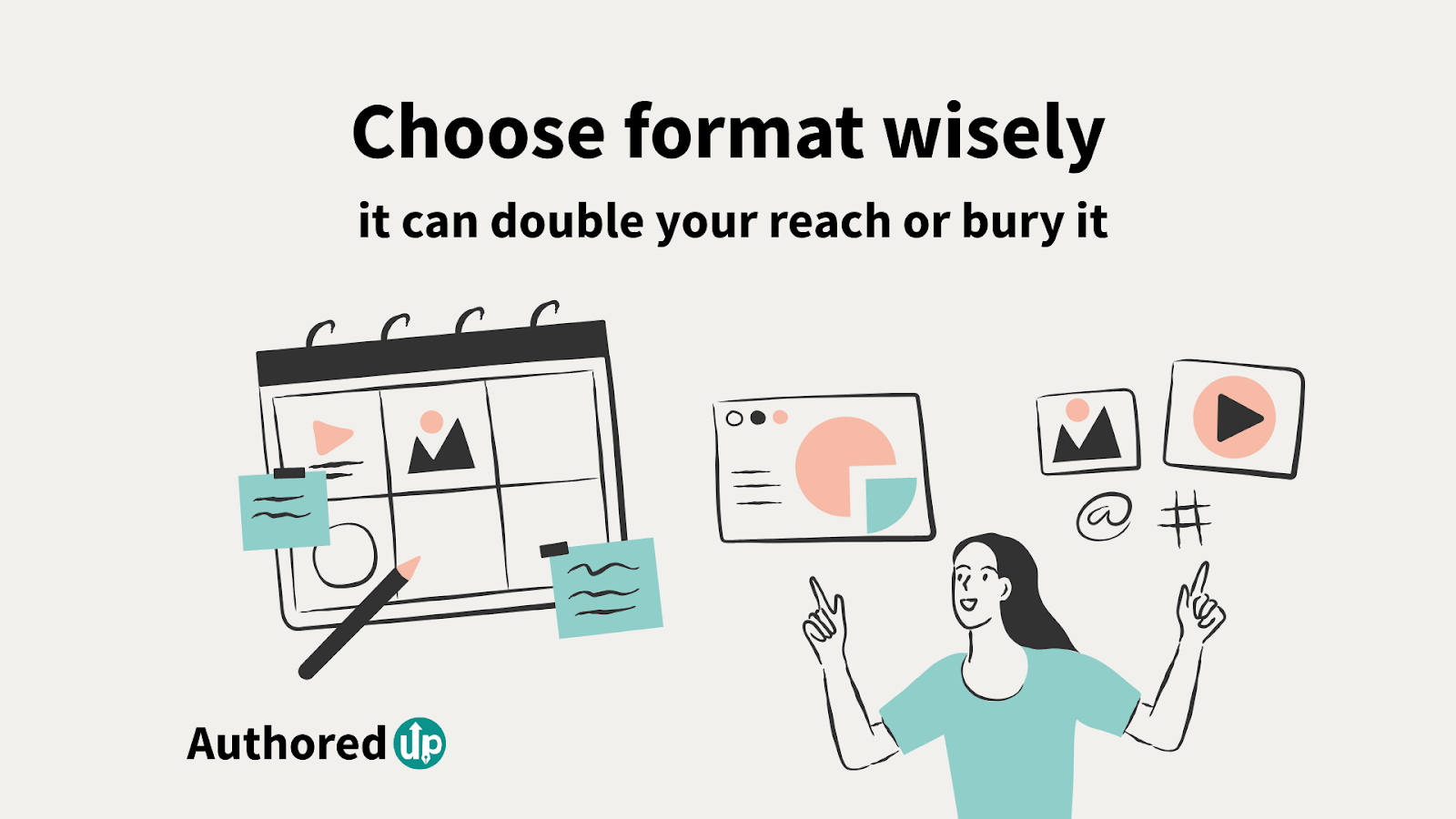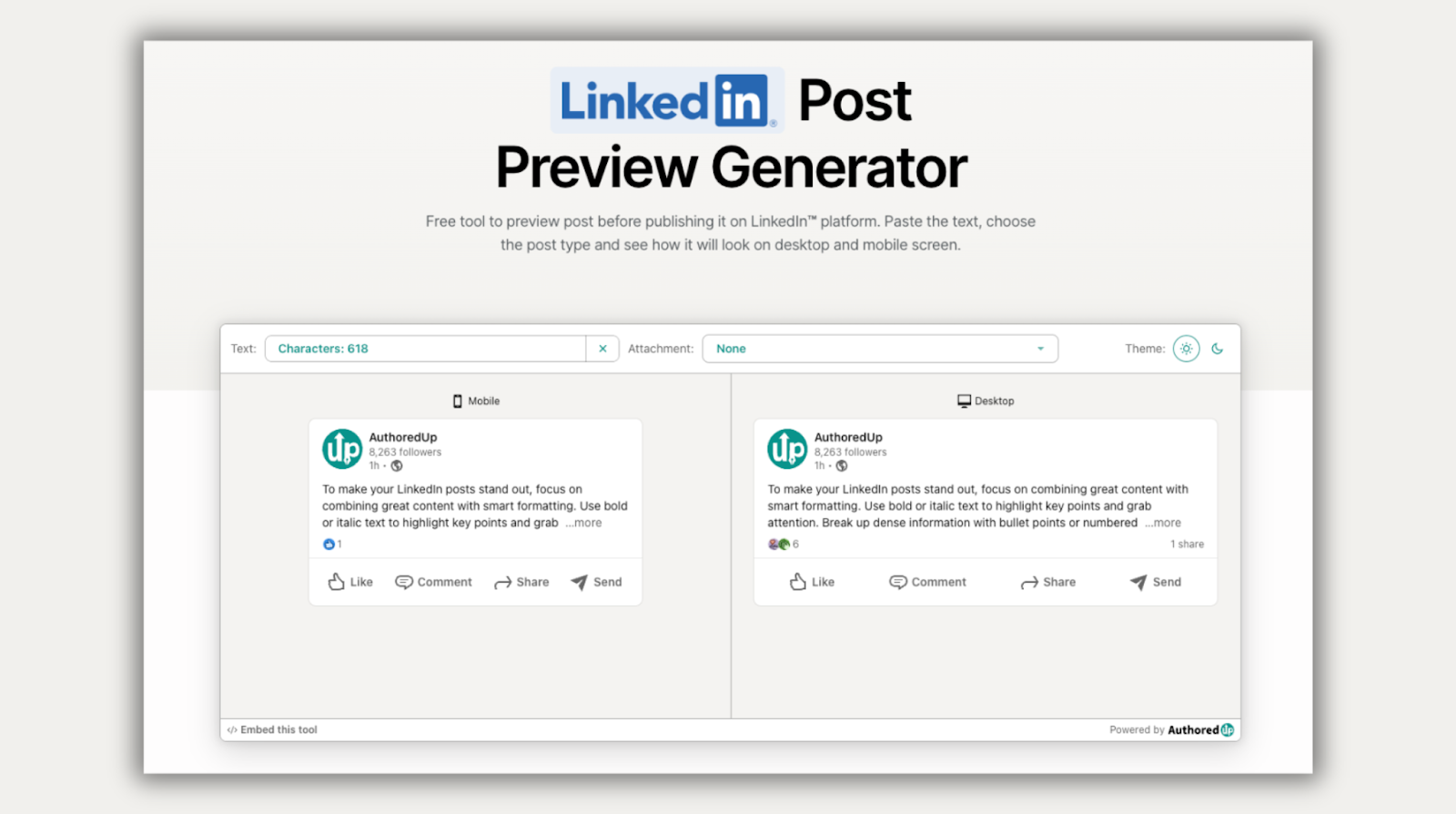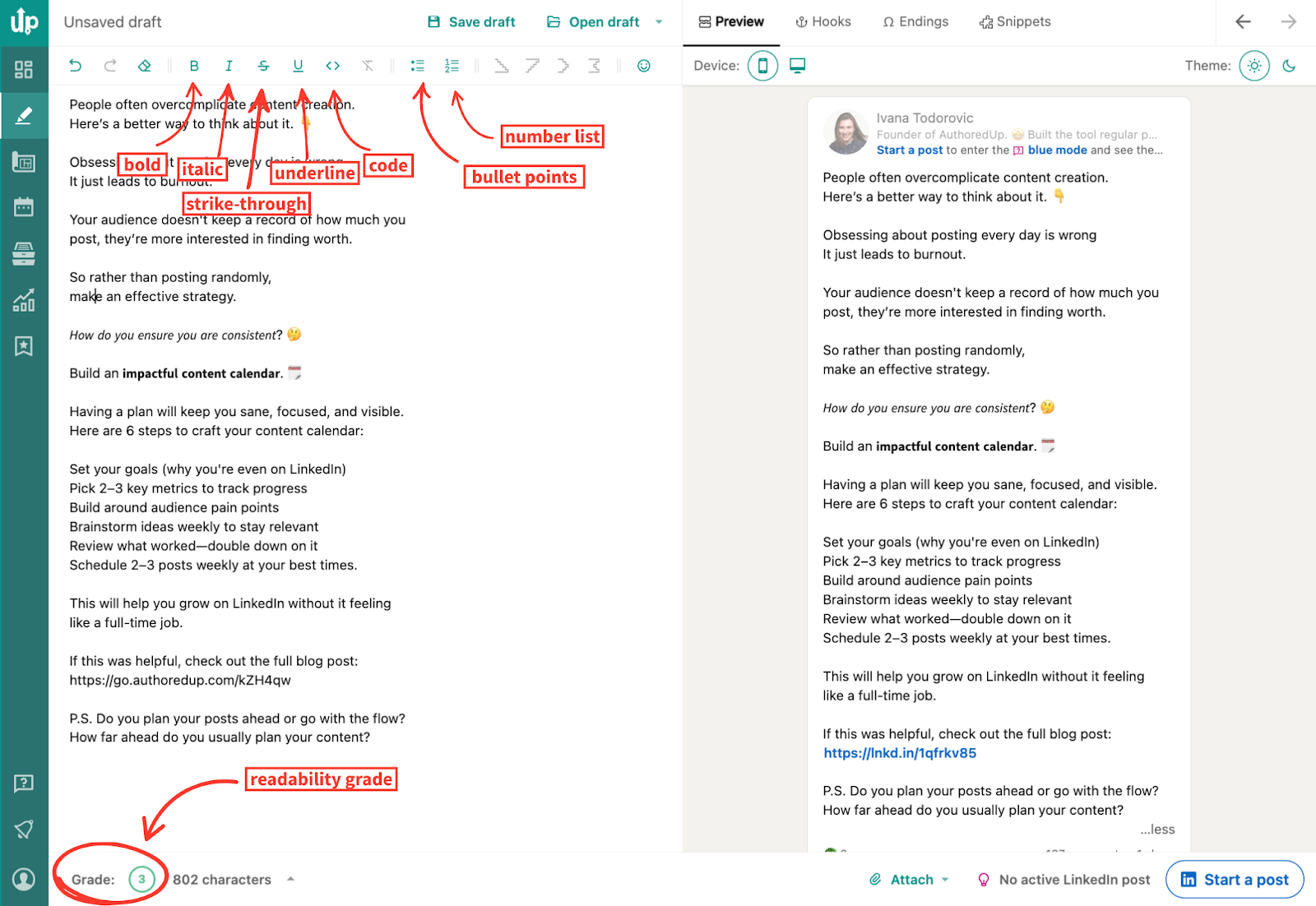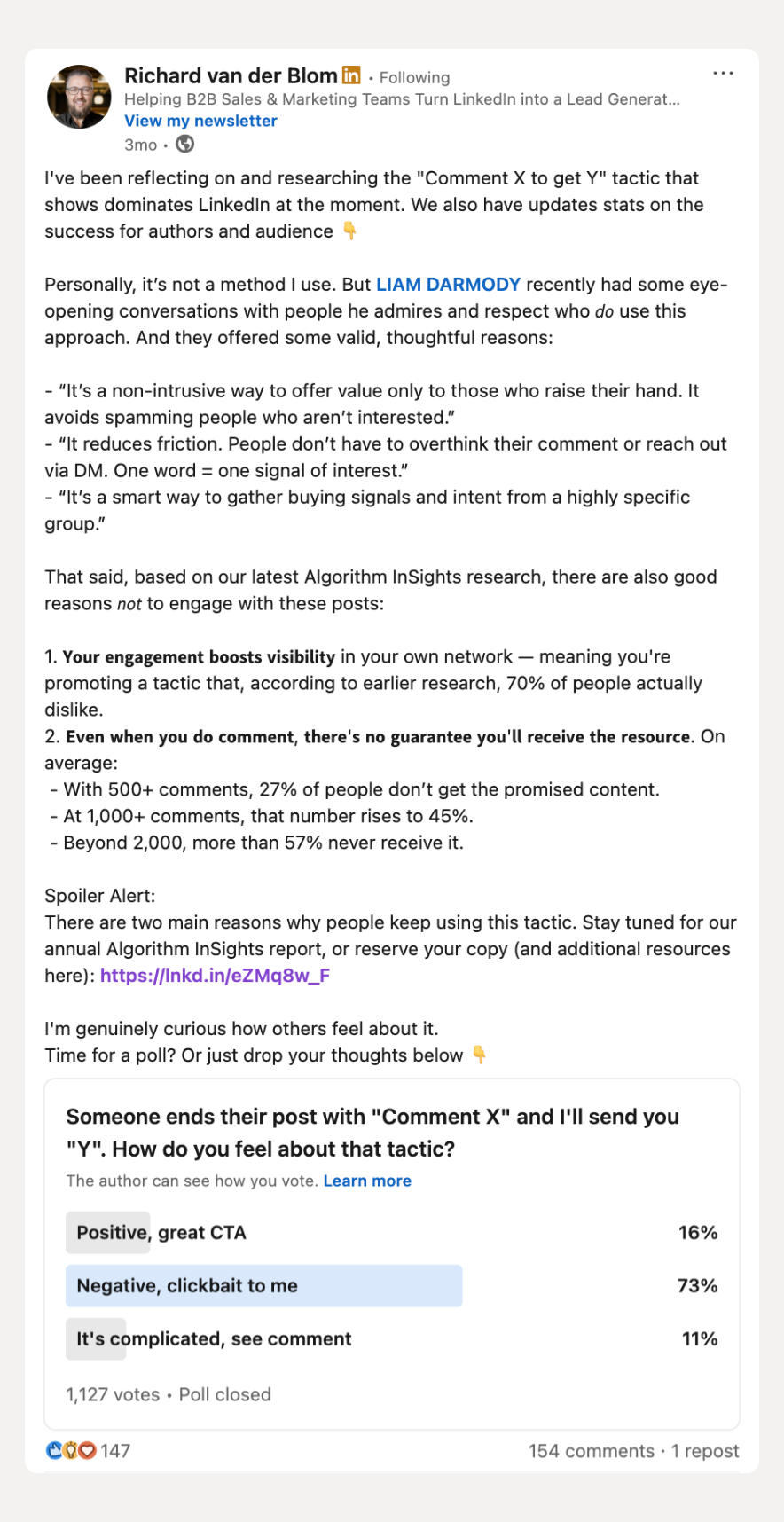You’re posting consistently, but visibility is flat.
Reach is down. Engagement feels random.
And your best content? Barely seen.
The problem isn’t your message; it’s about the formats you choose and how you use them.
We analyzed millions of posts to find what’s actually working on LinkedIn right now.
Here’s the no-fluff breakdown of which content types perform, which don’t, and how to use that data to post smarter.

What Content Performs Best on Linkedin
Not all content types perform equally on LinkedIn.
Image and video posts are leading the way, while text-only content is fading unless it’s sharp
Documents perform well when they are tight and tactical, and polls need a real purpose to earn attention.
What works now depends on so many things, and we’ll discuss them in the following.
So, let's jump right into it.
Image Posts
Image posts make up 58% of all LinkedIn content, and there is good reason for that. They're easy to consume, thumb-stopping on mobile, and they carry context fast.
Image posts are not trending because they’re flashy. They're winning because they work.
But not all images are equal.
Think of using stock photos or making a generic quotes post? People will scroll past it in a second.
What works:
- Screenshots of results, dashboards, or DMs
- Graphs or data visuals with clear takeaways
- Photos that add credibility-you speaking, working, presenting
Pair the image with a bold, benefit-driven opening line. Don’t explain the image, instead use it to frame the message.

Want to stand out? Design for the scroll.
Use contrast, whitespace, and text that’s readable in motion.
This post by Silja Engelstrof stands out because it delivers immediate value in a single visual.
Visual is well-designed, easy to grasp, and built for saving and resharing which is exactly what LinkedIn favors in the feed.
💡Pro tip
Ensure your posts appear polished across all devices with AuthoredUp's free Post Preview Generator. It allows you to see exactly how your content will look on both desktop and mobile screens, helping you optimize it for better performance.

By previewing your posts, you can make necessary adjustments to enhance visual appeal and engagement before hitting publish.
LinkedIn Videos
Video is LinkedIn’s fastest-rising format, with usage up 69%. It’s gaining in both reach (+23%) and engagement (+20%).
People nowadays love videos, probably because they're easy to digest. And if they love it, so does the algorithm.
We are all about numbers, but to be honest, if you go beyond them, something is for sure, sooner or later, the algorithm always follows and favors what the audience wants.
But what makes the video so successful?
Its ability to quickly grab attention (of course, if it’s good 🤓) and it keeps people on posts longer.
But here’s the catch: most LinkedIn videos still flop.
Why? Bad intros, no point, edited it for other platforms.
What works:
- Hook in the first 2 seconds with literally the first frame and sentence
- Short clips (30–120s) that explain, teach, or react
- Framing that’s direct, not polished
📌Note: Make sure it is uploaded directly to LinkedIn, not linked from other sites
Start with a face or a bold claim, cut fast, and most of all, always speak clearly.
Never forget to add captions, because most mobile users scroll silently.
This is a great example of native video done right. Alex B. Sheridan uses video to hook audience in the first second, delivers value fast, and keeps viewers engaged visually and verbally.
Text-Only Posts
Text-only posts used to dominate. But it is not the case anymore.
They dropped from 27% to 16% of all content. Reach is down 18%. Engagement? Even worse.
But that doesn’t mean they’re useless. It means the bar is higher.
If you're writing without visuals, your ideas have to hit harder. Otherwise, they will keep scrolling in search of something more engaging, and you will lose them forever.
What still works:
- Sharp contrarian takes
- Personal insights that actually teach
- Strong openers with emotional pull or surprise
Keep it punchy, clear, and structured by breaking text after every 2 to 3 lines. Use formatting options like bold and italics to guide attention.
Most importantly: say something worth reading. By not adding visuals, you're losing one dimension, so you must add additional value if you want to keep the audience at your post.
Attention spans are getting shorter, so if it doesn’t land in the first 3 seconds, it’s gone.
💡Pro Tip
The AuthoredUp Editor helps you structure posts that people actually read. Use bold, italics, bullet points to guide the eye, because most LinkedIn users scan, not read.

The built-in readability score keeps your post punchy, clear, and easy to follow, making it engaging even for fast readers.
Nick Broekema’s post shows how text-only can still perform when it’s clean, emotionally compelling, and offers a clear takeaway. By making it easy to scan with structure, he holds attention despite the lack of visuals.
Document
Carousels were once LinkedIn’s cheat code for explosive reach. But now? Results are mixed. Average reach has dropped by 18%, and engagement is down 25%.
That doesn’t mean carousels are doomed, just that their glow has worn off.
The format still works when you use it the right way.
Most carousels are too long, too vague, and too repetitive.
The logic behind it is likely that creators go with “the more, the better”, but too many slides that say the same thing in slightly different ways, draining attention instead of earning it.
If you want to see results:
- Choose 1080x1350px format
- Carousel cover needs to be engaging
- Add one clear idea per slide
- Create tactical content that includes checklists, frameworks, and templates
People swipe through carousels to learn something. But design matters just as much as the message.
One effective approach is to turn a process into clear, step-by-step slides.
For example: “How we did X” becomes Slide 1, Slide 2, Slide 3, and so on.
Another tactic is to repurpose longer posts by breaking them into shorter, visual chunks that are easier to follow and quicker to digest.
Hrabren Lindfors' carousel works here because it’s visually compelling and delivers a clear learning journey slide by slide. It turns a single idea into a swipe-worthy experience with punchy, skimmable insights.
Polls
Polls had their spike. For a while, they were the easiest way to grab fast engagement with minimal effort. That window is closing.
Reach is down 28%. Engagement is dropping. The format’s been overused because polls were used as more like shortcuts rather than content.
The same trick was used too many times, so users are ignoring it instinctively.
That doesn’t mean polls are useless, they can still be effective when used right.
If they’re tied to a real topic your audience cares about, so they can identify and really engage.
A well-placed question can open the door to discussion, especially if you use the results to spark a follow-up post or share your own perspective.
Then you won’t just be someone asking questions. You’ll be the one bringing value, doing them a favor by providing analysis they can actually use.
But avoid the surface-level stuff. Broad, generic questions fall flat. Polls only perform when they’re part of something bigger. Without that, it’s just noise.
So, don’t track just votes, but also real engagement later with comments, DMs, and profile views. And turn results into a content series. Build slides, record a video, or share an infographic to show what you learned.

Richard van der Bloom’s poll is set to succeed because it’s backed by original research and framed as a discussion, not clickbait.
The format works when the question sparks debate, and this one drew meaningful engagement.
Wrapping Up
Just because a content type performs well on average doesn’t mean it works best for your audience.
Everyone's network is different, so always compare what’s trending with what your data says.
Also, never stick to just one format, even if it’s performing well, because you may miss signals from other post types.
The only way to ensure your success is to check your own data, test different formats, and adapt.
That’s exactly where AuthoredUp comes in:
- Use the Editor to format your post for scannability and preview exactly how it will look across devices.
- Add hooks and endings from our library
- Track impressions, clicks, engagement, and performance by format, topic, and post structure.
- Save top-performing posts to study what worked and build on it.
- Store and revisit ideas using Drafts so you can experiment with different formats and test what lands.
- Plan your content with the calendar view to keep consistency.
- Review your full post history to identify real trends in your content.
It’s not about guessing what to post. It’s about knowing what’s working and doing more of that.
Read more
- Discover practical strategies to boost LinkedIn engagement and turn quiet posts into conversations.
- Find out which days deliver the most reach on LinkedIn and plan your content for maximum impact.
- Explore how LinkedIn's algorithm works and useful advanced strategies to drive success on LinkedIn.
How do I find your best‑performing posts on LinkedIn?
The fastest way is to start with your own data. Check your post analytics for impressions, engagement rate, and saves, and use those metrics to reveal what really resonates. Look for patterns in how your audience reacts to certain topics, what formats (images, videos, documents) drive more comments, and what content earns more shares and saves.
What kind of content is well received on LinkedIn?
LinkedIn rewards content that’s easy to engage with and feels relevant. Posts that mix value and authenticity work best. For example, those are think industry insights, quick data visuals, or personal stories with a takeaway.
In terms of format, image posts tend to stand out because they grab attention quickly and deliver context at a glance, especially on mobile. Native videos often outperform other types because they keep users on the platform and hold attention longer, while short, punchy text posts can still drive strong results if the message is clear and compelling right from the first line. But regardless of format, tone and usefulness play a major role. Our analysis shows that posts that read like a conversation tend to spark reactions, comments, and shares.
What is the 5‑3‑2 rule on LinkedIn?
The 5‑3‑2 rule is a simple posting framework:
- 5 posts should be value‑driven (tips, insights, data, tutorials).
- 3 posts should be curated (sharing someone else’s content with your take).
- 2 posts can be personal (stories, reflections, wins).
It’s not a strict formula, but it keeps your feed balanced. If every post feels like a pitch or every post is personal, people tune out. This mix helps you show up as credible, helpful, and human, which is a combination that performs best in the long term.
What kind of content goes viral on LinkedIn?
“Viral” on LinkedIn doesn’t mean TikTok‑style explosions. It means content that spreads far beyond your network. That usually happens when a post is:
- Immediately relatable (people see themselves in it)
- Shareable (data visual, quote, or checklist worth passing along)
- Built for interaction (questions that spark real discussion)
Examples: A clear graph showing industry change, a quick video with a bold opening, or a short story with a universal insight. Viral posts often pair emotional pull (pride, curiosity, frustration) with practical value (something worth saving).
What content does LinkedIn prioritize?
LinkedIn’s algorithm favors posts that keep people on the platform and spark engagement. That’s why:
- Native formats (images, videos, documents) outrank external links.
- Early engagement (likes, comments in the first hour) signals the post is worth showing to more people.
- Conversation‑starters (questions, prompts) perform better than statements.
Well‑structured posts with strong hooks and easy readability (breaks every 2–3 lines, clear visuals) make people pause longer, which tells LinkedIn, “This content is worth promoting.”



.svg)

.png)
.svg)
.png)
.svg)
.png)
.png)
